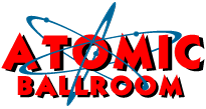What exactly is West Coast Swing and how does it differ from East Coast or other swing dances? For some this may seem like a silly question but for others who have yet to experience this dance craze, it is actually commonly wondered aloud.
As swing music and dance began to grow in popularity throughout the early 20th Century, it made its way around the world and began to evolve into various regional styles as it spread like wildfire throughout America. With more than ten distinct styles of swing dance, West Coast Swing has stood out from the rest with its smooth styling and broad mix of music used. In the 1940’s dance studios such as Arthur Murray, began teaching swing dances the way that they were being done in the clubs and streets by locals in each city. Some early trailblazers who led the way and danced in at least 100 movies at the time were Dean Collins, Lenny Smith and Lou Southern. They began training Arthur Murray instructors (like Swing competitor Lauré Haile) on the West Coast, who then named the style “Western Swing”. In 1959 Several California dance organizations changed the name to West Coast swing, to avoid confusion with country and western dancing.
West Coast Swing has seen a surge in popularity in recent years with its wide ranging appeal, attracting both young and old, pro and novice dancer, along with people from just about every walk of life. With this its not hard to understand why West Coast Swing became the state dance of California in 1989.
While some dances can take several months for a beginner to fully grasp basic concepts, part of WCS’s appeal is that a total beginner can grasp basic fundamentals after a relatively short period of time. Experts say that on average it takes a newcomer about 2-4 one-hour lessons to grasp the basic form of the dance, which is about 7 patterns. And although the basic footwork at its most basic level can be learned quickly, it can take a few months for the average newcomer to fully grasp a functional comprehension of West Coast Swings technical nuances. Using a double-beat rhythm structure (two walks) and triple beat rhythm (triple steps) over a six beat time frame (rather than eight beat musical phrase), can be tricky for newbies to get used to. Beyond that West Coast Swing has such broad appeal in that it is danced to so many genres of music; from Blues, Swing, R&B, Rock & Roll, Pop and even Cha-Cha. The dance itself even adds in elements from other dance styles like salsa, hustle and tango. This is what really sets it apart from other swing styles and many other dances.
The etiquette for West Coast Swing doesn’t differ much from a lot of other dance styles. Not teaching on the dance floor, using proper hygiene and being courteous to to other dancers (particularly during a collision), are all basic fundamentals for just about any dance social. The main thing dancers need to be aware of is that WCS utilizes slots or specific invisible lanes across the floor in which each couple is responsible for staying within. Unlike many ballroom dances where couples travel around the room, swing dancers are expected to dance back and forth in slots to maximize space and avoid collisions with other dancers. Apart from these elements, all participants have to do is to be prepared to work up a sweat and have fun dancing to a host of of hits that will take you on a music journey all across America.
Listed is a mix of classic songs often heard at West Coast Swing competitions along with current top requested hits from dance floors across the globe to get you started :
Swing : Fly Me to the Moon – Frank Sinatra
Pop : Love Never Felt So Good – Michael Jackson
Boogie Blues : Roadrunner – Microwave Dave and the Nukes
Soul : Think – Aretha Franklin
Hip-Hop : Whistle – Flo Rida
Cha-Cha : Smooth – Santana
R&B : Tonight (Best You’ve Ever Had) – John Legend
Acoustic : Man In the Mirror – James Morrison
Funk : Brick House – Commodores
Rock & Roll : Stagger Lee – Fabulous Thunderbirds

